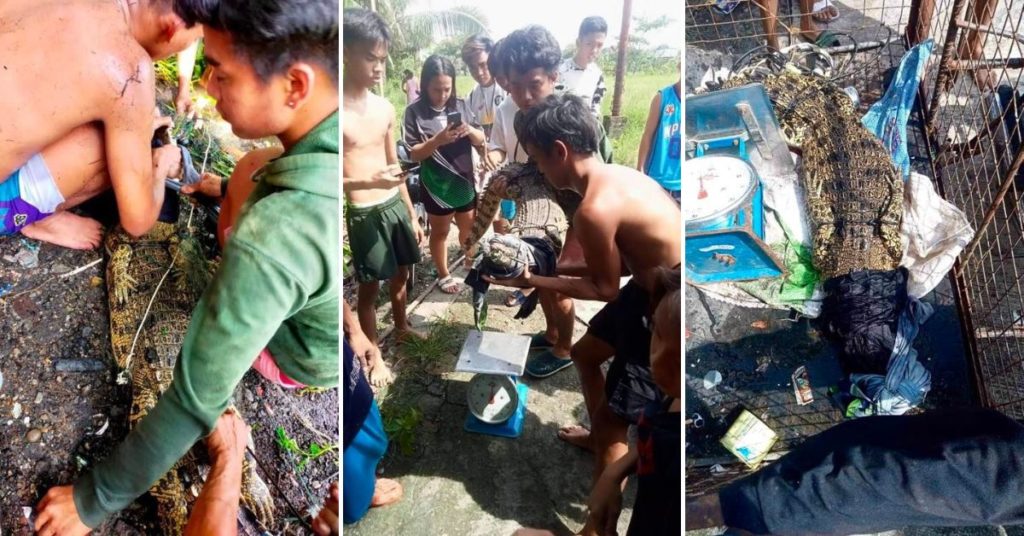Around late June of this year, a netizen from Sitio Tabon of Brgy. Malis in Guiguinto, Bulacan, posted a picture of a crocodile roaming freely among water lilies in the river. The photo went viral and caught the attention of the local government unit (LGU) of Guiguinto and the media.
Representatives from the Biodiversity Management Bureau (BMB) of the Department of Environment and Natural Resources (DENR) started an investigation on June 27, 2022, into the reported presence of crocodiles in the river.
“We acknowledge that there are alleged sightings and have reported the matter to the DENR for immediate investigation and action,” Mayor Paula Agatha “Agay” Cruz. She said a team from the BMB conducted an ocular inspection.
In a post on Facebook dated June 27, 2022, officials of Barangay Malis warned the public against swimming or going to the river, citing the reported sightings of a crocodile.

“Mahigpit na ipinagbabawal ang pagpunta sa ilog at ang pagligo dito dahil sa may namamataang BUWAYA sa ilog. Ito ay naireport na sa kinauukulan tulad ng DENR, Municipal Environment and Natural Resources Office (MENRO), Municipal Disaster Risk Reduction Management Office (MDRRMO), Mayor’s Office. Para maiwasan ang ano mang kapahamakan ng lahat inaasahan ang inyong lubos na pakikiisa at lubos na pag iingat,” Brgy. Malis officials said.
“Para sa mas mabilis na paghuli sa nasabing BUWAYA sa mga naninirahan malapit sa ilog kung mayroon kayong makitang buwaya mangyaring iparating kaagad sa ating barangay [For the immediate capture of the said crocodile among those living near the river, please report it to our barangay immediately],” they added.
What kind of crocodile is this?
According to an expert who saw the photo, it is a saltwater crocodile and is estimated to be five to six feet long. Crocodiles are not indigenous to the area, and officials said they had no idea how the croc made it into the Guiguinto river.
The scientific name of the saltwater crocodile is Crocodylus porosus. They are native to brackish and freshwater regions of eastern India, Southeast Asia, Micronesia, and northern Australia. They are excellent swimmers and have often been spotted far out at sea and in freshwater habitats. They are regarded as apex predators and dangerous to humans.
The saltwater crocodile is the largest living reptile. Males grow to a length of up to 6 m (20 ft), rarely exceeding 6.3 m (21 ft) or weight of 1,000–1,300 kg (2,200–2,900 lb). Females are much smaller and rarely surpass 3 m (10 ft).
How did they catch this reptile?
According to the news, authorities and locals set up traps and snares along the river path where they spotted the croc. On July 17, 2022, the crocodile was finally captured alive with the help of brave residents of Sitio Tabon.
According to Mr. Zaldy, one of the rescuers and a resident, his brother spotted the crocodile in a rice field near the river in Barangay Malis. Using wooden planks, sticks, towels, and nets, more than ten people helped each other to catch this elusive reptile.

The crocodile was turned over safely and is now under the care of the Biodiversity Management Bureau (BMB) of the Department of Environment and Natural Resources (DENR).
Read Impressive FB Harrison and Guiguinto Connection, Complete List of Memorial Parks in Bulacan 2022, and Controversial 6 Legislative Districts of Bulacan
Sources:
- Manny Balbin July 18, 2022. (n.d.). Crocodile captured in Bulacan River. Philippine News Agency. Retrieved August 1, 2022, from https://www.pna.gov.ph/articles/1179176
- Lazaro, R. E. (2022, June 28). Crocodiles sighted in Bulacan River? Philstar.com. Retrieved August 1, 2022, from https://www.philstar.com/nation/2022/06/29/2191608/crocodiles-sighted-bulacan-river
- Velez, F. (2022, July 18). Crocodile captured in Bulacan River. Manila Bulletin. Retrieved August 1, 2022, from https://mb.com.ph/2022/07/18/crocodile-captured-in-bulacan-river/
- Saltwater Crocodile: National Geographic. Animals. (n.d.). Retrieved August 1, 2022, from https://www.nationalgeographic.com/animals/reptiles/facts/saltwater-crocodile
- Saltwater Crocodile. Oceana. (2022, July 14). Retrieved August 1, 2022, from https://oceana.org/marine-life/saltwater-crocodile/